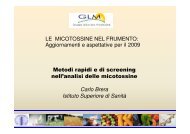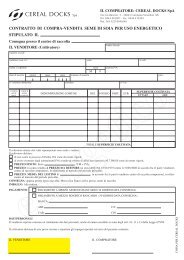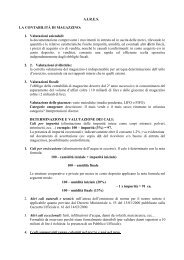âMycotoxin Binderâ?
âMycotoxin Binderâ?
âMycotoxin Binderâ?
You also want an ePaper? Increase the reach of your titles
YUMPU automatically turns print PDFs into web optimized ePapers that Google loves.
Fusarium-toxin Forum of 1 - 2 February 2010 1<br />
Joint Research Centre (JRC)<br />
Analytical Aspects of<br />
Mycotoxin Binders<br />
Anna Kolossova & Joerg Stroka<br />
http://www.jrc.ec.europa.eu/
Overview<br />
Fusarium-toxin Forum of 1 - 2 February 2010 2<br />
Legal background<br />
Type of Binders (structure)<br />
Binders available to test in the study<br />
Design/outline of study and evaluation<br />
Analytical methods used<br />
Statistical evaluation<br />
Conclusion
Legislation first…<br />
Fusarium-toxin Forum of 1 - 2 February 2010 3
Some background<br />
Fusarium-toxin Forum of 1 - 2 February 2010 4<br />
My first contact with “binders”…<br />
http://www.inkanatura.com/macawclaylicks.asp<br />
Macaws in Peru<br />
Munn, C.A., 1994. Macaws: winged rainbows. Natl. Geograph. 185:118-140.<br />
TD Phillips is working with Don Brightsmith, Head of Rainforest Expeditions, to<br />
determine the reason for geophagy in Macaws in Peru.<br />
Humans in Ghana
What has research been focussed on?<br />
Fusarium-toxin Forum of 1 - 2 February 2010 5<br />
Animal health (in vivo)<br />
Metabolic indicators (in vivo)<br />
Cell culture studies (in vitro)<br />
Isotherm studies (analysis of suspensions)<br />
Effects on analysis????
Methods for prevention and decontamination<br />
of mycotoxins<br />
Fusarium-toxin Forum of 1 - 2 February 2010 6<br />
• Prevention of mycotoxin contamination<br />
• Pre- and post-harvest control and harvest management<br />
• Codex Alimentarius – codes of practice for the prevention and reduction<br />
of mycotoxins in cereals, peanuts, apple products, raw materials<br />
• The use of HACCP – to consider in the future<br />
• Although the prevention of mycotoxin contamination in the field is the<br />
main goal of agricultural and food industries, under certain environmental<br />
conditions the contamination of various commodities with mycotoxins is<br />
unavoidable<br />
• Detoxification of mycotoxins<br />
• Removal from contaminated commodities<br />
• Inactivation of mycotoxins by physical, chemical or biological methods<br />
• Neither the use of chemical decontamination processes, nor the mixing of<br />
batches with the aim of decreasing the level of contamination below the<br />
maximum tolerable level are legal within the EU<br />
Mycotoxins can not be entirely eliminated
Mycotoxin binders<br />
Fusarium-toxin Forum of 1 - 2 February 2010 7<br />
A mycotoxin binder (adsorbent/denaturant) added to the<br />
diet should be able to interact in vivo with mycotoxins<br />
and restrict their absorption in the GI tract of animals<br />
Several requirements for a mycotoxin binder<br />
• Effective inactivation of mycotoxins of interest<br />
• Reduction of mycotoxin bioavailability/activity<br />
• Availability of essential nutrients to an animal<br />
• Not being detrimental to animal or food product<br />
• Not being a growth promoter (growth promotion may mask<br />
mycotoxins)<br />
• Demonstrate verifiable positive results (improvement of zootechnical<br />
performance; recovery of organ status; excretion of mycotoxins via<br />
faeces; recovery of the immune status)<br />
• Technical and economical feasibility
Types of Mycotoxin Binders<br />
Fusarium-toxin Forum of 1 - 2 February 2010 8<br />
• Adsorbents<br />
• Inorganic<br />
• Activated charcoal<br />
• Aluminosilicates, clays<br />
HSCAS, bentonite, montmorillonite, zeolite, clinoptilolite…<br />
Clay minerals – layered silicates [Si 2 O 5<br />
2-<br />
] xy<br />
Zeolite – silicate made of tetrahedrons of SiO 4 and AlO 4<br />
• Chemically treated silicates<br />
• Organic<br />
• Chemical polymers (cholestyramine, polyvinylpyrrolidone,<br />
divinylbenzene-styrene polymers…) High costs<br />
• Glucan products<br />
Yeast and products from yeast (yeast cell wall)
Types of Mycotoxin Binders<br />
Fusarium-toxin Forum of 1 - 2 February 2010 9<br />
Denaturant<br />
• Mycotoxin-degrading enzymes<br />
• Life microorganisms producing mycotoxin-degrading enzymes<br />
• Eubacterium sp. (BBSH 797)<br />
• T. mycotoxinivorans<br />
• Organic binders<br />
• Efficient against a larger range of mycotoxins than inorganic binders<br />
• More adapted to the most frequent cases of multi-contaminated feeds<br />
• Biodegradable and do not accumulate in the environment after being<br />
excreted by animals
Oltipraz a “Mycotoxin Binder”?<br />
Fusarium-toxin Forum of 1 - 2 February 2010 10<br />
http://phm.utoronto.ca/~jeffh/jnppres.ppt
Level of Interest for Testing Mycotoxin Binders<br />
Fusarium-toxin Forum of 1 - 2 February 2010 11
Level of Interest for Testing Mycotoxin Binders<br />
Fusarium-toxin Forum of 1 - 2 February 2010 12
Analytical aspects<br />
Fusarium-toxin Forum of 1 - 2 February 2010 13<br />
Cascade of modern analytical Methods:<br />
– Extraction<br />
– Clean-up / Dilution<br />
– Separation<br />
– Detection
Methods used for testing<br />
Fusarium-toxin Forum of 1 - 2 February 2010 14<br />
Official Methods (or those in standardization process):<br />
• Aflatoxin B1 EN ISO 17375:2006<br />
• Deoxynivalenol prEN 15791:2009<br />
• Zearalenone prEN 15792:2009<br />
• Ochratoxin A WD N954 of TC327/WG1<br />
• Fumonisins WD N953 of TC327/WG1<br />
• T2 and HT2 toxins Breidbach et.al. under consideration as a<br />
prospective CEN standard.
Repeatability Data of the Test Methods<br />
Fusarium-toxin Forum of 1 - 2 February 2010 15<br />
Mycotoxin<br />
DON<br />
AFB1<br />
ZEA<br />
T2 & HT2 toxins<br />
FUM B1 + B2<br />
OTA<br />
Average RSD r<br />
(%)<br />
10.6<br />
6.9<br />
7.7<br />
9.8<br />
3.2<br />
4.1
Tested Binders in this Study<br />
Fusarium-toxin Forum of 1 - 2 February 2010 16<br />
Code<br />
Type of main product(s)<br />
pH value<br />
Amount added [%]<br />
1<br />
Yeast cell wall<br />
2.9<br />
0.2<br />
2<br />
Clay + organic acid<br />
7.9<br />
0.1<br />
3<br />
Clay<br />
8.4<br />
0.1<br />
4<br />
Clay<br />
4.6<br />
0.25<br />
5<br />
Yeast cell wall<br />
6.2<br />
0.2<br />
6<br />
Yeast cell wall<br />
6.7<br />
0.2<br />
7<br />
Yeast cell wall<br />
4.7<br />
0.25<br />
8<br />
Mixture organic + mineral<br />
6.2<br />
0.25<br />
9<br />
Yeast cell wall<br />
5.0<br />
0.2<br />
10<br />
Mixture organic + mineral component<br />
8.6<br />
0.25<br />
11<br />
Mixture organic + mineral component<br />
6.9<br />
0.25<br />
12<br />
Clay<br />
9.1<br />
0.5<br />
13<br />
Clay<br />
8.9<br />
1<br />
14<br />
Fibres<br />
6.7<br />
1<br />
15<br />
Montmorillonite<br />
10.4<br />
0.4<br />
16<br />
Montmorillonite<br />
10.6<br />
0.4<br />
17<br />
HSCAS<br />
8.8<br />
0.5<br />
18<br />
HSCAS<br />
9.8<br />
0.5<br />
19<br />
HSCAS<br />
9.8<br />
0.5<br />
20<br />
Fibres (lignocellulose)<br />
5.1<br />
2.5
Some Statistics<br />
Fusarium-toxin Forum of 1 - 2 February 2010 17<br />
Data analysis<br />
Student’s t-test (independent two-sample t-test with unequal sample<br />
sizes and equal variance). Differences were assumed to be<br />
significant at p < 0.05.<br />
Critical t-values (p = 0.05) were compared with those obtained by the<br />
Student’s t-test according to the following formula:<br />
t<br />
=<br />
S<br />
X1−<br />
X 2<br />
1 1<br />
× +<br />
n1<br />
n2<br />
Statistical Advisor: A. Breidbach
Aflatoxin B1<br />
Fusarium-toxin Forum of 1 - 2 February 2010 18<br />
120<br />
100<br />
Retrieval of aflatoxin B 1<br />
, %<br />
80<br />
60<br />
40<br />
20<br />
0<br />
1 2 3 4 5 6 7 8 9 10 11 12 13 14 15 16 17 18 19 20<br />
Binder
DON<br />
Fusarium-toxin Forum of 1 - 2 February 2010 19<br />
120<br />
Retrieval of deoxynivalenol, %<br />
100<br />
80<br />
60<br />
40<br />
20<br />
0<br />
1 2 3 4 5 6 7 8 9 10 11 12 13 14 15 16 17 18 19 20<br />
Binder
ZON (combined binders)<br />
Fusarium-toxin Forum of 1 - 2 February 2010 20<br />
100<br />
Retrieval of zearalenone, %<br />
80<br />
60<br />
40<br />
20<br />
0<br />
A B C D E<br />
Binder group
OTA (combined binders)<br />
Fusarium-toxin Forum of 1 - 2 February 2010 21<br />
100<br />
Retrieval of ochratoxin A, %<br />
80<br />
60<br />
40<br />
20<br />
0<br />
A B C D E<br />
Binder group
Fumonisins (combined binders)<br />
Fusarium-toxin Forum of 1 - 2 February 2010 22<br />
100<br />
Retrieval of fumonisins B 1<br />
& B 2<br />
, %<br />
80<br />
60<br />
40<br />
20<br />
0<br />
A B C D E<br />
Binder group
T-2 & HT-2 toxins<br />
Fusarium-toxin Forum of 1 - 2 February 2010 23<br />
120<br />
Retrieval of T-2 & HT-2 toxins, %<br />
100<br />
80<br />
60<br />
40<br />
20<br />
0<br />
A B C D E<br />
Binder group
Recent Findings (FAC-A) on AfB1<br />
Fusarium-toxin Forum of 1 - 2 February 2010 24
Recent Findings (FAC-A) on DON<br />
Fusarium-toxin Forum of 1 - 2 February 2010 25
AfB1 to AfM1 transformation in the presence of binders<br />
Fusarium-toxin Forum of 1 - 2 February 2010 26
Conclusion<br />
Fusarium-toxin Forum of 1 - 2 February 2010 27<br />
The addition of the tested binders (at the level<br />
indicated by the manufacturer) did not result in<br />
lower analytical values for any mycotoxin<br />
currently regulated in feed.<br />
The combined effect of processing such as wet<br />
heating, pH-change, etc. in the presence of<br />
mycotoxin binders was not investigated, but<br />
might be a subject of interest for other studies.
Collaborators<br />
Fusarium-toxin Forum of 1 - 2 February 2010 28<br />
Ouissam Abbas and Vincent Baeten<br />
In collaboration with<br />
Alexandro Rodriguez<br />
Walloon Agricultural Research Centre<br />
Quality of Agricultural Products Department<br />
Chaussée de Namur, 24<br />
B – 5030 GEMBLOUX<br />
Tél :++ 32 (0) 81/62.03.50<br />
Fax : ++ 32 (0) 81/62.03.88<br />
baeten@cra.wallonie.be<br />
http://cra.wallonie.be
IRMM staff behind the scene<br />
Fusarium-toxin Forum of 1 - 2 February 2010 29<br />
Massimo Ambrosio<br />
Katy Kroeger<br />
Katrien Bouten
Open Call for Collaborators<br />
Fusarium-toxin Forum of 1 - 2 February 2010 30<br />
IRMM is looking for collaborators for projects on:<br />
characterisation studies<br />
homogeneity and stability studies, and<br />
feasibility studies<br />
As well as for scientific staff (e.g. post docs)<br />
www.irmm.jrc.be/html/calls/call_for_collaborators/index.htm<br />
www.irmm.jrc.be/html/job_opportunities/index.htm






![C[1].tto 103 - Granoturco nazionale - Inter-Associativo](https://img.yumpu.com/24141627/1/184x260/c1tto-103-granoturco-nazionale-inter-associativo.jpg?quality=85)


